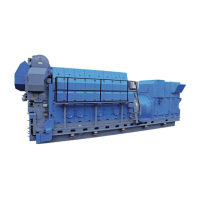been done, the engine coolant must be immediately treated with anticorro-
sive agent. Once the engine has been brought back into operation, the
cleaned system must be checked for leaks.
Regular checks of the coolant condition and coolant system
Treated coolant may become contaminated when the engine is in operation,
which causes the additive to loose some of its effectiveness. It is therefore
advisable to regularly check the cooling system and the coolant condition. To
determine leakages in the lube oil system, it is advisable to carry out regular
checks of water in the expansion tank. Indications of oil content in water are,
e.g. discoloration or a visible oil film on the surface of the water sample.
The additive concentration must be checked at least once a week using the
test kits specified by the manufacturer. The results must be documented.
Concentrations of chemical additives
The chemical additive concentrations shall not be less than the
minimum concentrations indicated in the table
„Nitrite-containing
chemical additives“
.
Excessively low concentrations lead to corrosion and must be avoided. Con-
centrations that are somewhat higher do not cause damage. Concentrations
that are more than twice as high as recommended should be avoided.
Every 2 to 6 months, a coolant sample must be sent to an independent labo-
ratory or to the engine manufacturer for an integrated analysis.
If chemical additives or antifreeze agents are used, coolant should be
replaced after 3 years at the latest.
If there is a high concentration of solids (rust) in the system, the water must
be completely replaced and entire system carefully cleaned.
Deposits in the cooling system may be caused by fluids that enter the cool-
ant or by emulsion break-up, corrosion in the system, and limescale deposits
if the water is very hard. If the concentration of chloride ions has increased,
this generally indicates that seawater has entered the system. The maximum
specified concentration of 50 mg chloride ions per kg must not be exceeded
as otherwise the risk of corrosion is too high. If exhaust gas enters the cool-
ant, this can lead to a sudden drop in the pH value or to an increase in the
sulphate content.
Water losses must be compensated for by filling with untreated water that
meets the quality requirements specified in the paragraph
Requirements. The
concentration of anticorrosive agent must subsequently be checked and
adjusted if necessary.
Subsequent checks of the coolant are especially required if the coolant had
to be drained off in order to carry out repairs or maintenance.
Protective measures
Anticorrosive agents contain chemical compounds that can pose a risk to
health or the environment if incorrectly used. Comply with the directions in
the manufacturer's material safety data sheets.
2017-08-18 - de
Specification of engine coolant D010.000.023-13-0001
General
MAN Diesel & Turbo
010.000.023-13
D010.000.023-13-0001 EN 5 (7)

